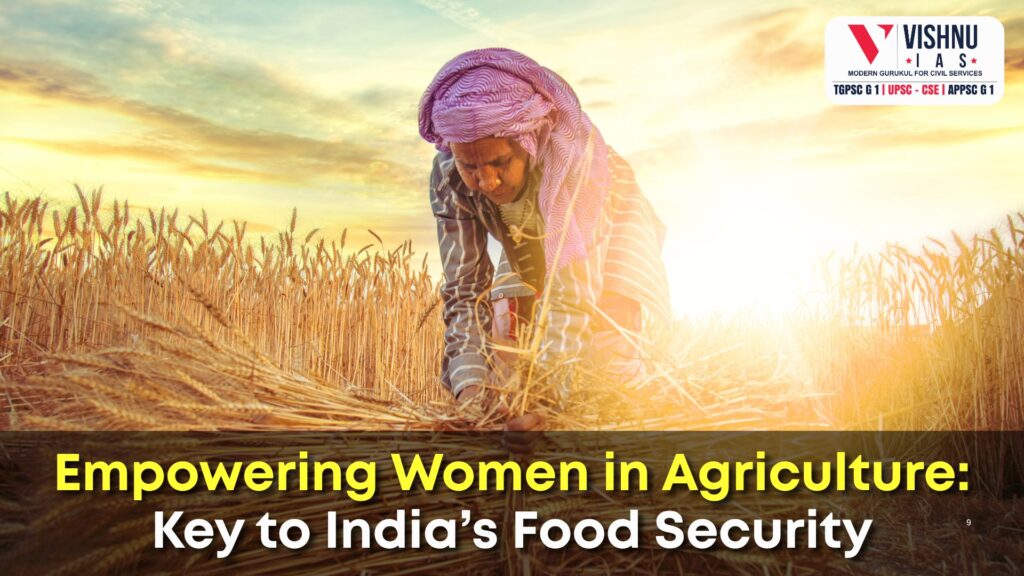Empowering Women in Agriculture: Key to India’s Food Security
Empowering women in agriculture is not just a matter of gender equity—it is essential for ensuring food security in India. Women form the backbone of Indian agriculture, yet they continue to face systemic challenges in land ownership, access to technology, and resilience to climate change. Recognizing this, the United Nations has declared 2026 as the International Year of the Woman Farmer, highlighting their contributions and the urgent need for reform.
Key Contributions and Statistics
1. Workforce Participation
- Women constitute about 75% of full-time farm labor in India.
- 62 million women are engaged as agricultural labourers (Census 2011).
- 80% of rural women depend on agriculture for their livelihood (ICAR data).
- Women are responsible for 60-80% of food production in India.
2. Land Ownership
- Less than 10% of Indian women own land; some estimates suggest as low as 5.5% (AIDIS 2019).
- NFHS-5 estimates women’s land ownership at 31.7%, but this is likely inflated due to methodology.
- Only 12.8% of operational holdings are owned by women, mostly marginal and small holdings.
3. Access to Credit and Resources
- Only 26% of female cultivators had access to direct agricultural credit (Census 2011), compared to 55% for males.
- Women agricultural workers earn 20-30% less than their male counterparts.
- Less than 5% of Indian firms have some female ownership (World Bank).
4. Government Initiatives
- Mahila Kisan Sashaktikaran Pariyojana (MKSP): Skill and livelihood support for women in agriculture.
- National Food Security Mission (NFSM): 30% of funds earmarked for women farmers in 28 states.
- Sub-Mission on Agricultural Mechanisation (SMAM): 50-80% subsidies on farm machinery, with 10% extra for women.
- National Mission on Oilseeds and Oil Palm (NMOOP): 30% budget for women beneficiaries.
- Digital Agriculture Mission (2021-2025): Promotes AI, IoT, and digital tools for women farmers.
5. Challenges and Barriers
- Limited Land Rights: Limits access to credit, schemes, and decision-making.
- Technology Gap: Digital illiteracy, device costs, and lack of local content hinder access.
- Climate Vulnerability: Female-headed farms lose more income from heat and floods (FAO data).
- Socio-cultural Barriers: Mobility restrictions, unpaid care work, and exclusion from decision-making.
- Gender Wage Gap: Persistent 20-30% lower wages for women in agriculture.
6. Innovations and Success Stories
- ENACT Project (Assam): Connects women with mobile agri-advisories and climate-resilient farming.
- Agri-Tech Startups: Platforms like Kalgudi, CropIn, and DeHaat offer AI-driven support tailored for women.
- Women Agripreneurs: Pioneers like Smt. Binita Kumari from Bihar show the power of innovation and entrepreneurship.
7. Policy Recommendations and Dimensions
- Collect gender-disaggregated data to enable targeted interventions.
- Promote women-led agri-value chains and businesses.
- Strengthen Self-Help Groups (SHGs) to boost bargaining power and resource sharing.
- Expand access to climate-resilient technologies and advisory services.
- Increase women’s financial inclusion through credit and crop insurance.
- Boost digital literacy and skill development in farm technologies.
Conclusion
Empowering women in agriculture is not just about fairness—it is fundamental to achieving food security in India. While women play a central role in agricultural production, persistent challenges around land rights, credit access, technology, and climate resilience must be addressed. With targeted reforms, government support, and digital innovations, India can unlock the full potential of its women farmers and drive inclusive rural growth.


